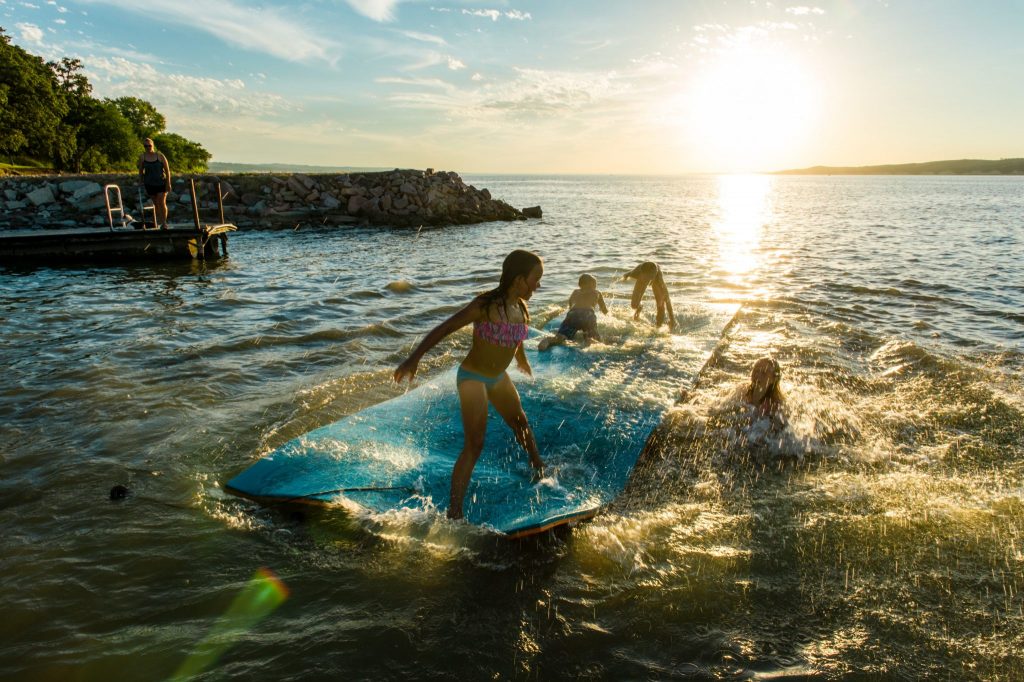
By Jamie Bachmann, Wildlife Educator
The words “risk” and “children” rarely fit comfortably in the same sentence. Well-meaning parents, myself included, do all we can to protect the most innocent from what we perceive as risk. We bandage every scrape. We make them aware of every potential danger they, assumingly, can’t possibly see. We remove every possible hazard within a two-mile radius. What happens, then, when those children inevitably go out into the world and have not developed the skills to assess and evaluate risk? Are we doing an entire generation of children a disservice? As an outdoor educator, I claim the following: Children who are exposed to risky situations have more opportunity to develop skills in assessing risk.
The following is an example of what might be going through a child’s mind when assessing a potential risk:
1. Recognizing risk: “Hey risk, there you are.”
2. Considering risk: “Hmmm, what’s at stake here if I do this? What are the dangers? And what are the consequences?”
3. Responding to risk: “Do I want to avoid this risk? Or can I figure out an appropriate way to take this risk?”
Before we dive in, let’s establish that risk taking doesn’t have to equate with recklessness. For example, we all took risks when learning how to walk as a toddler. And as adults, we take risks when applying for jobs, when choosing whom to love, when trying a new topping on our pizza or reading a book from an author we’ve not read before. Taking a risk is a leap into the unknown where we continually gather information to assess the possibility of success or failure based on our goals.
Early childhood is the time when risk assessment begins its development, and within that time frame, play is where children do most of their learning. Outdoor play, specifically, provides opportunity for “risky” challenges that nurture a child’s healthy judgment of success and failure. I’m talking about the kind of play that can fill a parent with anxiety and make them prone to redirecting play to something “safer”: Tree climbing, poking at a campfire, playing by or in water, jumping from high places, and running through tall grass are examples of outdoor activities that carry relative risk. However, it is within this type of play when children are challenged: They learn to think through potential dangers in their choices. Because let’s face it, parents. You aren’t always going be around to point out those things.
Tree climbing, for example, can help children test their strengths, identify their limitations and learn about injuries. Injury doesn’t need to be something as traumatic as brain injury for a child to learn. Exposure to minor injuries such as a scrape from tree bark or jabs from tree branches are a collection of experiential learning that can actually lead to the prevention of a fall, which can be more serious. Children who are allowed to engage with risk during play cultivate their understanding of cause and effect while nurturing their development of risk assessment. Most children will want to climb that tree, and someday, we may not be there to tell them, “No, it’s not safe.” Should we prepare them for it, or do we shelter them?
Ironically, children have a natural curiosity and connection to “risky” outdoor play. Outdoor play is not a structured, sterilized plastic playground regulated by safety standards. These types of play spaces do not reflect the developmental needs of children, but rather the goal is to prevent or reduce risk. How many of you have seen children playing on a piece of equipment in a way that was not its intended use? Kids do this because they are bored and seeking out experiences that provide them more stimulation. They want to test boundaries and challenge their minds and bodies.
When a child climbs to the very top of a dirt mound with every intention of jumping, the outcome is uncertain. Uncertainty creates familiarity with the associated emotions of anxiety and fear, which hopefully leads to learning how to cope with those emotions. For example, when you take action in the face with uncertainty, you must be prepared to be wrong and to learn from that experience. We begin learning from a young age that it takes persistence and courage to learn from our mistakes and to try again until we achieve our goals, in spite of our fears. As that child is deciding if the jump is going to hurt, or maybe checking out more appropriate places from which to launch, with adult guidance that child learns that fear is nothing to fear. Studies support that repeated exposure to fear-inducing situations during play can help children develop the ability to cope. One study reported that rats deprived of play during critical developmental periods showed excessive fear, inappropriate aggression and exaggerated emotional reactions to stressful situations in maturity.
Finally, I would like to point out that the leading mental disorder among children and adolescents is anxiety.
Professor David Eager and Dr. Helen Little, experts on Risk Deficit Disorder, defined RDD as “a lack of risk-taking that leads to lack of ability or knowledge to perceive and then deal with risk.”
I know, I know, another disorder. Another worry that busy parents need to consider in order to have healthy and happy children – another opportunity to fail at parenting. But this can be easily remedied, as I believe that risk deficit disorder is akin to nature deficit disorder, which is a phrase coined by outdoor writer Richard Louv who has written extensively on the “human cost of alienation from nature.”
Perhaps, as parents, we should consider risk deficit disorder and nature deficit disorder more closely. They might provide clues to alleviating some of the underlying causes of our most alarming societal ills.
